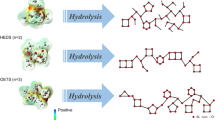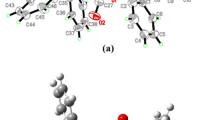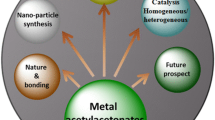Abstract
The nitrate esters are important components of double-base propellants. Aromatic amines are recommended as the stabilizers to delay the decomposition of nitrate esters and increase their storage time. The decomposition mechanisms of alkyl, alkoxy dinitrate, and poly-fluoride nitrate esters and the stabilizing effect of aromatic amines including new designed phenols are studied at the level of B3LYP/6-31G**. Alkyl and alkoxyl dinitrate esters are likely to be transformed by hydrogen abstraction, which is consistent with that of mononitrate and trinitrate esters. However, for poly-fluoride nitrate esters, NO2 catalyzed self-decomposition is preferred. In addition, comparing with mononitrate and trinitrate esters, the order of their stability is mononitrates > dinitrates > trinitrates. Poly-fluoride nitrate esters have a poorer stability than non-fluorinated nitrate esters. Comparing with parent nitrate esters, the stability of new designed poly-fluoride oxygen-containing nitrate esters is slightly improved. Aromatic amines including new designed phenols are effective stabilizers of nitrate esters, especially when introduced hydroxyl in the para position, can enhance the effects of stabilizers. The rate constants for the decomposition of nitrate esters and the bimolecular reaction between stabilizers and NO2 are calculated by using traditional transition state theory.

Comparison between the reaction energy barrier of nitrate esters and stabilizers with NO2








Similar content being viewed by others
References
Agrawal JP, Surve RN, Mehilal, Sonawane SH (2000) Some aromatic nitrate esters: synthesis, structural aspects, thermal and explosive properties. J Hazard Mater 77(1):11–31. https://doi.org/10.1016/S0304-3894(00)00235-1
Chavez DE, Hiskey MA, Naud DL, Parrish D (2008) Synthesis of an energetic nitrate ester. Angew Chem 120(43):8431–8433. https://doi.org/10.1002/anie.200803648
Deshmukh MB, Wagh ND, Sikder AK, Borse AU, Dalal DS (2014) Cyclodextrin nitrate ester/H2SO4 as a novel nitrating system for eficient synthesis of insensitive high explosive 3-nitro-1,2,4-triazol-5-one. Ind Eng Chem Res 53(50):19375–19379. https://doi.org/10.1021/ie502555a
McDonald BA (2011) Study of the effects of aging under humidity control on the thermal decomposition of NC/NG/BTTN/RDX propellants. Propellants Explos Pyrotech 36(6):576–583. https://doi.org/10.1002/prep.200900094
Bohn MA (2002) Kinetic description of mass loss data for the assessment of stability, compatibility and aging of energetic components and formulations exemplified with ε-Cl20. Propellants Explos Pyrotech 27(3):125–135. https://doi.org/10.1002/1521-4087(200206)27:3<125::AID-PREP125>3.0.CO;2-4
Bohn MA et al (2009) Prediction of in-service time period of three differently stabilized single base propellants. Propellants Explos Pyrotech 34(3):252–266. https://doi.org/10.1002/prep.200900007
Druet L, Asselin M (1988) A review of stability test methods for gun and mortar propellants, II: Stability testing and surveillance. J Energy Mater 6(3-4):215–254. https://doi.org/10.1080/07370658808012555
Monoruzzaman M, Bellerby JM, Bohn MA (2014) Activation energies for the decomposition of nitrate ester groups at the anhydroglucopyranose ring positions C2, C3 and C6 of nitrocellulose using the nitration of a dye as probe. Polym Degrad Stab 102:49–58. https://doi.org/10.1016/j.polymdegradstab.2014.02.002
Zeng XL, Chen WH, Liu JC, Kan JL (2008) Experimental and theoretical studying the thermolysis of nitrate. J Therm Anal Calorim 91(2):359–363. https://doi.org/10.1007/s10973-007-8360-9
Zeng XL, Chen WH, Liu JC, Kan JL (2007) A theoretical study of five nitrates: electronic structure and bond dissociation energies. THEOCHEM J Mol Struct 810(1):47–51. https://doi.org/10.1016/j.theochem.2007.01.040
Li MM, Guo XW, Li F, Song HC (2009) Theoretical studies on the structures, thermodynamic properties, detonation performance, and pyrolysis mechanisms for six dinitrate esters. Chin J Chem 27(10):1871–1878. https://doi.org/10.1002/cjoc.200990314
Yan QL, Zhu WH, Pang AM, Chi XH, Du XJ, Xiao HM (2013) Theoretical studies on the unimolecular decomposition of nitroglycerin. J Mol Model 19(4):1617–1626. https://doi.org/10.1007/s00894-012-1724-5
Venter A, Ifa DR, Cooks RG, Poehlein SK, Chin A, Ellison D (2006) A desorption electrospray ionization mass spectrometry study of aging products of diphenylamine stabilizer in double-base propellants. Propellants Explos Pyrotech 31(6):472–476. https://doi.org/10.1002/prep.200600064
Sun ZD, Fu XL, Yu HJ, Fan XZ, Ju XH (2017) Theoretical study on stabilization mechanisms of nitrate esters using aromatic amines as stabilizers. J Hazard Mater 339(5):401–408. https://doi.org/10.1016/j.jhazmat.2017.06.025
Pei LG, Dong KH, Tang YH, Zhang B, Yu C, Li WZ (2017) Theoretical studies of the decomposition mechanisms of 1,2,4-butanetriol trinitrate. J Mol Model 24(1):6. https://doi.org/10.1007/s00894-017-3541-3
Pei LG, Dong KH, Tang YH, Zhang B, Yu C, Li WZ (2017) A density functional theory study of the decomposition mechanism of nitroglycerin. J Mol Model 23(9):269. https://doi.org/10.1007/s00894-017-3440-7
Buszek RJ, Soto D, Dailey JM, Bolden S, Tall TL, Hudgens LM, Marshall CA, Boatz JA, Drake GW (2017) Structures and binding energies of nitrate plasticizers DEGDN, TEGDN and nitroglycerine. Propellants Explos Pyrotech 42:1–8. https://doi.org/10.1002/prep.201700203
Bellerby JM, Blackman CS (2004) The interaction between otto fuel II and aqueous hydroxylammonium perchlorate (HAP), Part I: Initial observations and time to event measurements. Propellants Explos Pyrotech 29(5):262–266. https://doi.org/10.1002/prep.200400055
Powell S, Franzmann PD, Cord-Ruwisch R, Toze S (1998) Degradation of 2-nitrodiphenylamine, a component of Otto Fuel II by clostridiumspp. Anaerobe 4(2):95–102. https://doi.org/10.1006/anae.1997.0141
Fettaka H, Lefebvra MH (2016) Propylene glycol dinitrate (PGDN) as an explosive taggant. Cent Eur J Energy Mater 13(3):627–640. https://doi.org/10.22211/cejem/65007
Srinivas D, Ghule VD (2016) Synthesis of nitrate ester and nitramine derivatives of polyfluoro alkyl compounds for high energy materials. RSC Adv 6:7712–7716. https://doi.org/10.1039/c5ra24615f
Krumlinde P, Ek S, Tunestal E, Hafstrand A (2016) Synthesis and characterization of novel stabilizers for nitrocellulose-based propellants. Propellants Explos Pyrotech 42:78–83. https://doi.org/10.1002/prep.201600122
Andrés J, Canle M, Garcı́a MV, Rodrııguez LF, Vázquezb, Santaballa JA (2001) A B3LYP/6-31G** study on the chlorination of ammonia by hypochlorous acid. Chem Phys Lett 342(3-4):405–410. https://doi.org/10.1016/S0009-2614(01)00579-6
Srinivasan S, Lee MW, Grady MC, Soroush M, Rappe AM (2011) Computational evidence for self-initiation in spontaneous high-temperature polymerization of methyl methacrylate. J Phys Chem A 115(6):1125–1132. https://doi.org/10.1021/jp107704h
Mulliner D, Wondrousch D, Schüürmann G (2011) Predicting michael-acceptor reactivity and toxicity through quantum chemical transition-state calculations. Org Biomol Chem 9(24):8400–8412. https://doi.org/10.1039/c1ob06065a
Frisch MJ, Trucks GW, Schlegel HB, Scuseria GE, Robb MA, Cheeseman JR, Scalmani G, Barone V, Mennucci B, Petersson GA, Nakatsuji H, Caricato M, Li X, Hratchian HP, Izmaylov AF, Bloino J, Zheng G, Sonnenberg JL, Hada M, Ehara M, Toyota K, Fukuda R, Hasegawa J, Ishida M, Nakajima T, Honda Y, Kitao O, Nakai H, Vreven T, Montgomery Jr JA, Peralta JE, Ogliaro F, Bearpark M, Heyd JJ, Brothers E, Kudin KN, Staroverov VN, Kobayashi R, Normand J, Raghavachari K, Rendell A, Burant JC, Iyengar SS, Tomasi J, Cossi M, Rega N, Millam NJ, Klene M, Knox JE, Cross JB, Bakken V, Adamo C, Jaramillo J, Gomperts R, Stratmann RE, Yazyev O, Austin AJ, Cammi R, Pomelli C, Ochterski JW, Martin RL, Morokuma K, Zakrzewski VG, Voth GA, Salvador P, Dannenberg JJ, Dapprich S, Daniels AD, Farkas Ö, Foresman JB, Ortiz JV, Cioslowski J, Fox DJ (2009) Gaussian 09, revision A.1. Gaussian Inc., Wallingford
Rooney JJ (1995) Eyring transition-state theory and kinetics in catalysis. J Mol Catal A Chem 96(1):L1–L3. https://doi.org/10.1016/1381-1169(94)00054-9
Sogami M, Era S, Murakami M, Seo Y, Watari H, Uyesaka N (2001) Application of the transition state theory to water transport across cell membranes. Biochim Biophys Acta 1511(1):42-48. https://doi.org/10.1016/S0005-2736(00)00384-9
Zhuo LG, Liao W, Yu ZX (2012) A frontier molecular orbital theory approach to understanding the mayr equation and to quantifying nucleophilicity and electrophilicity by using HOMO and LUMO Energies. Asian J Org Chem 1(4):336–345. https://doi.org/10.1002/ajoc.201200103
Trache D, Tarchoun AF (2018) Stabilizers for nitrate ester-based energetic materials and their mechanism of action: a state-of-the-art review. J Mater Sci 53:100–123. https://doi.org/10.1007/s10853-017-1474-y
Shehata AB, Hassan MA, Nour MA (2003) Effect of new poly 2-acryloyl-N,N′-bis (4-nitrophenyl) propandiamide and poly 2-acryloyl-N,N′-bis (4-methylphenyl) propandiamide and their synergistic action on the stability of nitrocellulose. J Hazard Mater 102(2):121–136. https://doi.org/10.1016/S0304-3894(03)00138-9
Lussier LS, Bergeron E, Gagnon H (2006) Study of the daughter products of akardite-II. Propellants Explos Pyrotech 31(4):253–262. https://doi.org/10.1002/prep.200600034
Zayed MA, Mohamed AA, Hassan MA (2010) Stability studies of double-base propellants with centralite and malonanilide stabilizers using MO calculations in comparison to thermal studies. J Hazard Mater 179(1-3):453–461. https://doi.org/10.1016/j.jhazmat.2010.03.025
Funding
This work was supported by the fund of key technology research and development projects (20190302130GX), Jilin Province Science and Technology Department.
Author information
Authors and Affiliations
Corresponding author
Additional information
Publisher’s note
Springer Nature remains neutral with regard to jurisdictional claims in published maps and institutional affiliations.
Highlights
• Mechanisms of decompositions for dinitrate esters are elaborated.
• Mechanisms of the reactions between stabilizers and NO2 are elucidated.
• New nitrate esters containing fluoride/oxygen and stabilizers are designed.
• Relevant kinetic studies of stabilizers and nitrate esters are investigated.
Electronic supplementary material
ESM 1
(DOCX 1723 kb)
Rights and permissions
About this article
Cite this article
Sun, Y., Ni, S. & Pan, Xm. Theoretical study on the mechanisms of the decomposition of nitrate esters and the stabilization of aromatic amines. J Mol Model 25, 346 (2019). https://doi.org/10.1007/s00894-019-4245-7
Received:
Accepted:
Published:
DOI: https://doi.org/10.1007/s00894-019-4245-7




